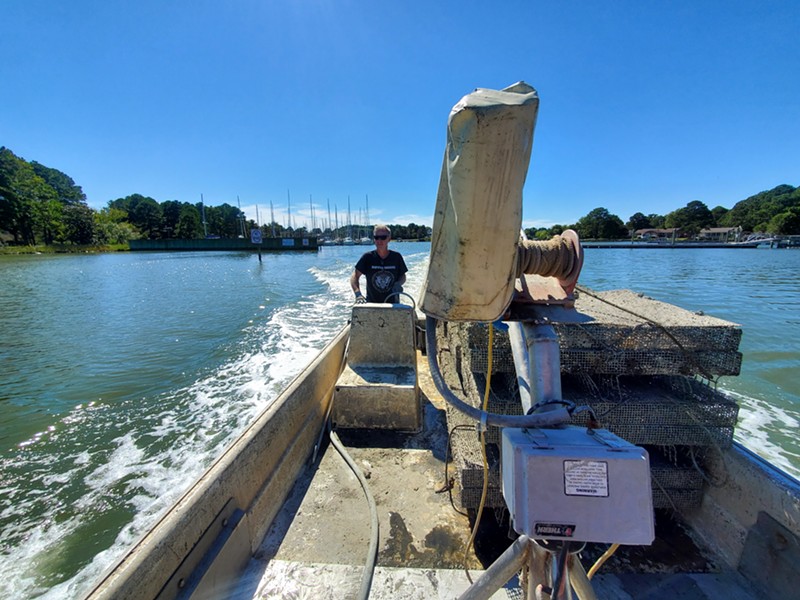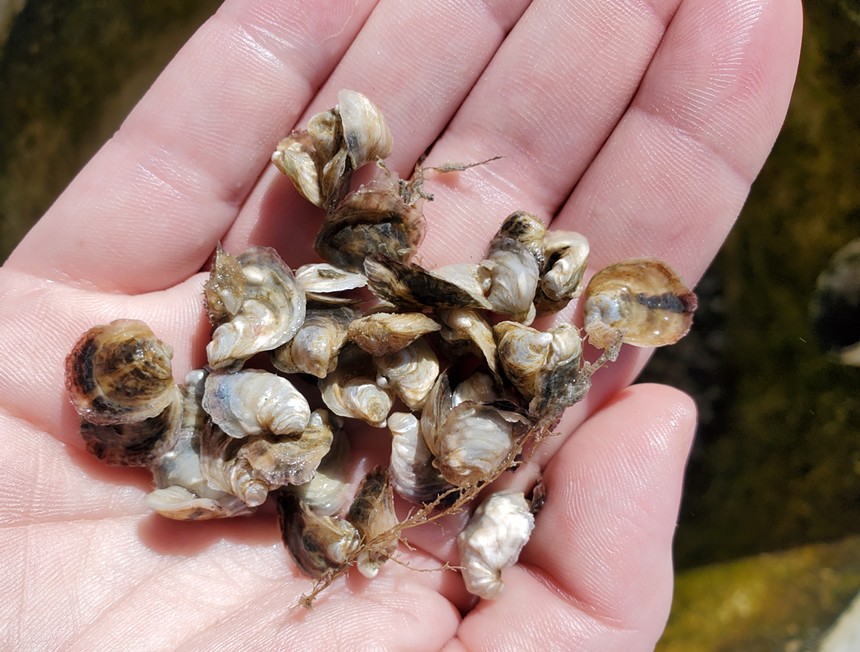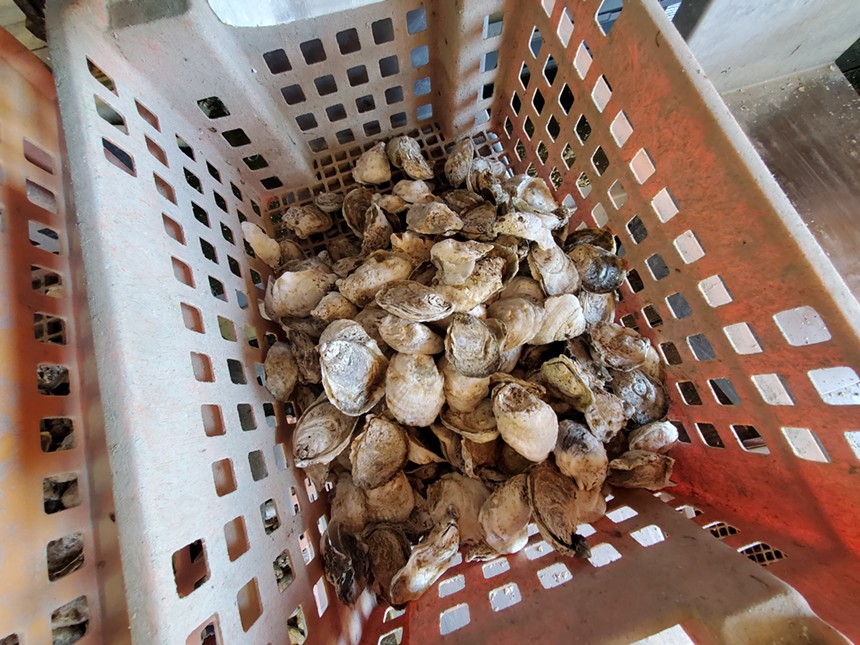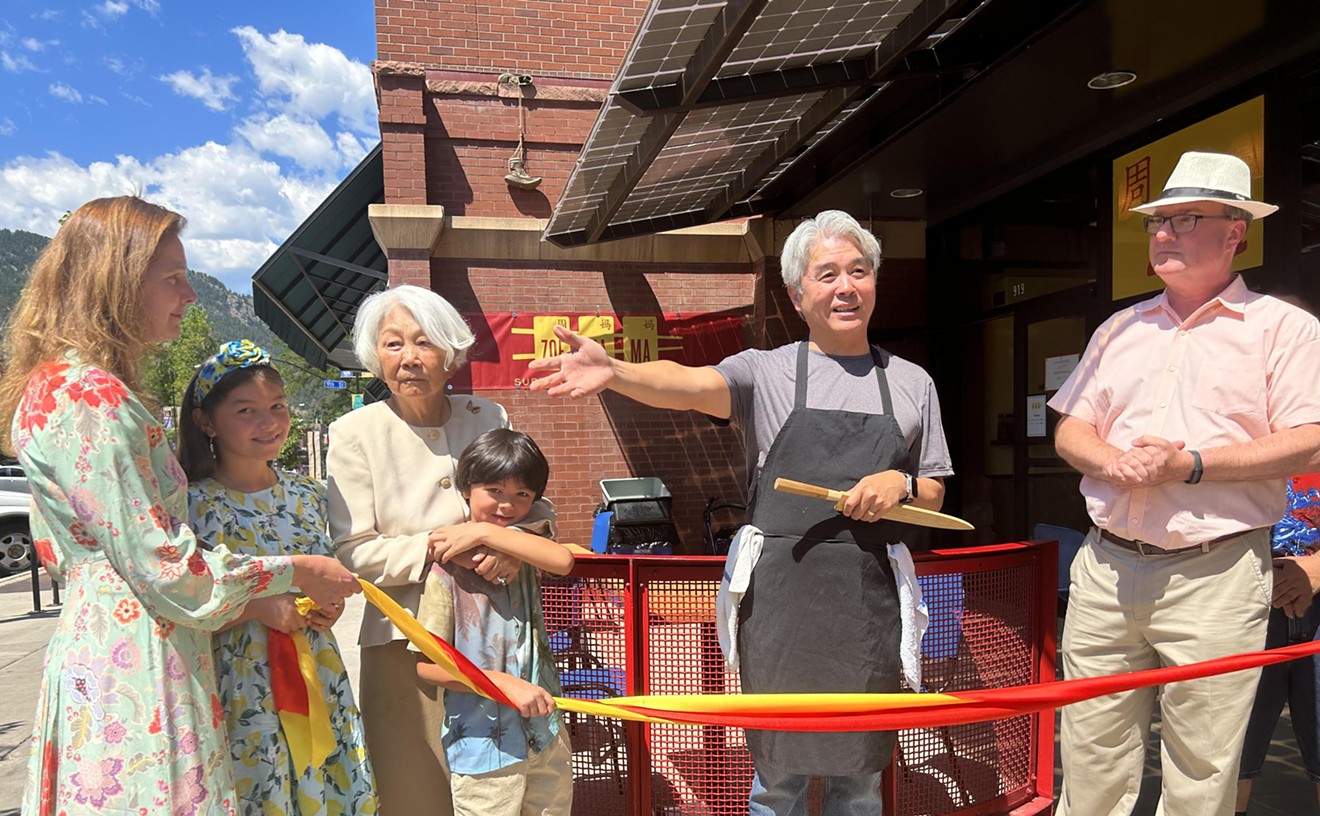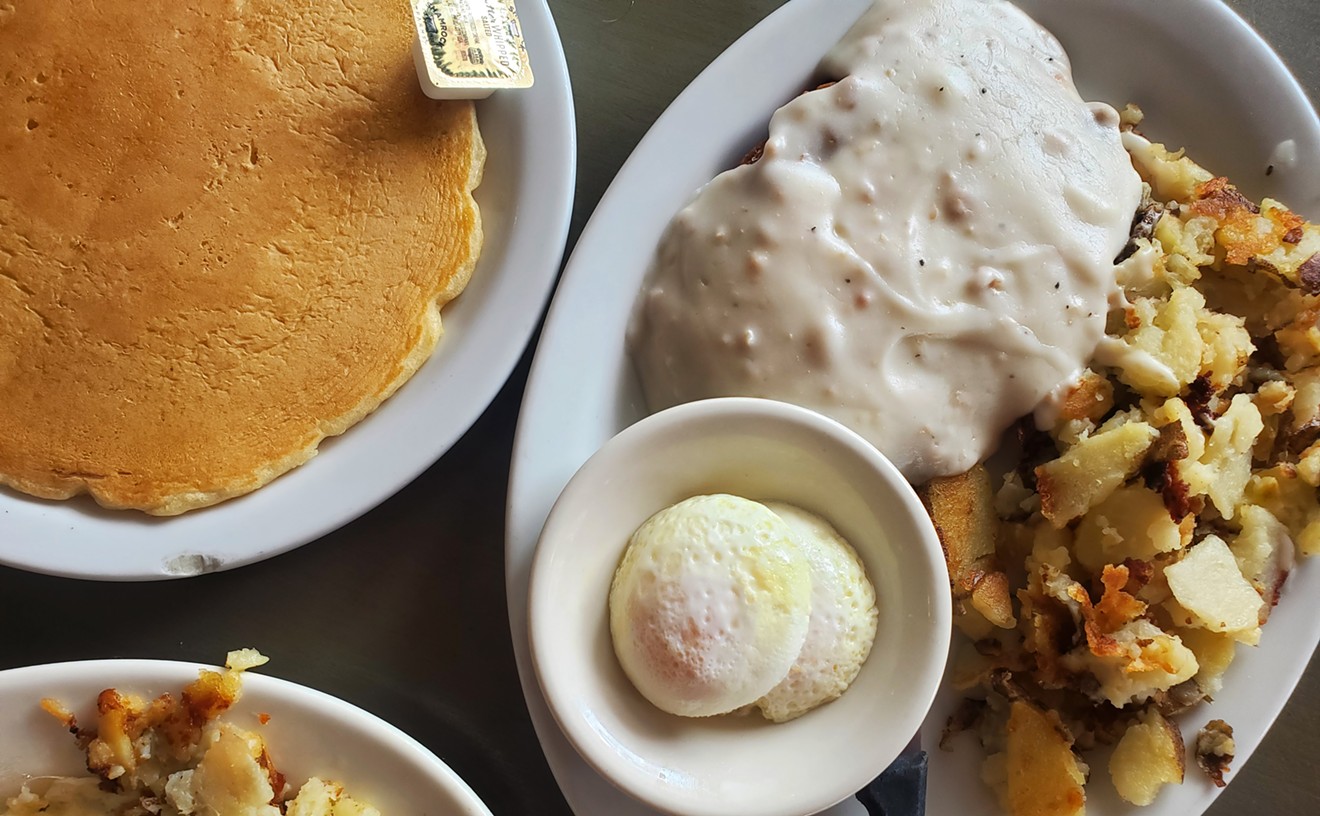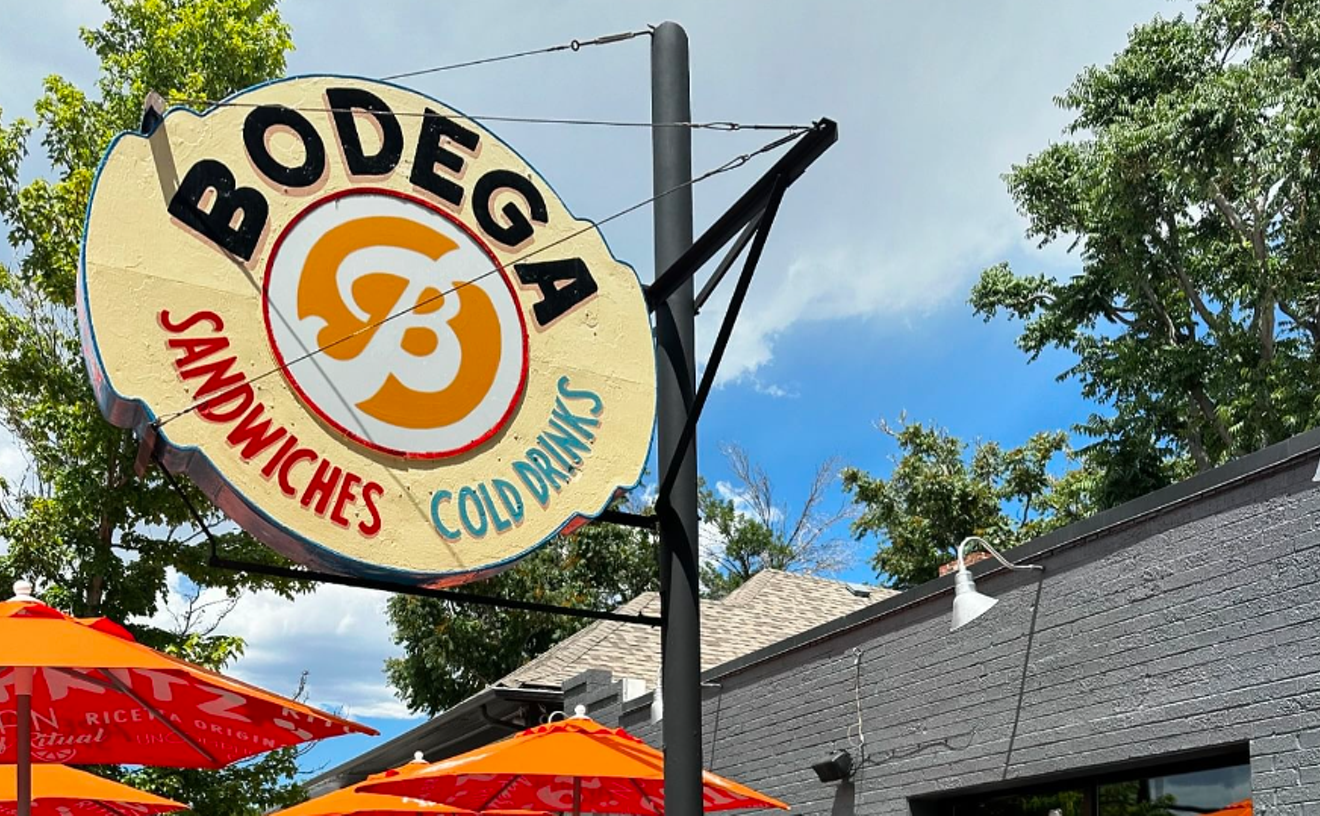Over 1,700 miles away, in Topping, Virginia, near the Chesapeake Bay, a dozen raw oysters are served at an outdoor table overlooking the water at Merroir, one of six eateries owned by the Rappahannock Oyster Co. Like terroir with wine, the word "merroir" reflects the fact that the flavor of an oyster changes depending on where it's grown, when it's grown and the conditions that year.
On a dock just feet from the restaurant, cage after cage is hauled in off shallow boats on the Rappahannock River. Each is filled with oysters of varying sizes — hundreds of thousands per day. A small crew works from early morning to late afternoon year-round, tending to the ongoing harvest of Crassostrea virginica, the oyster species that is native to the area. After a 24-to-36-month growth cycle, oysters that have reached the right size for distribution are packed on ice and shipped all over the country, including to Denver.
"Jax gets our oysters before Richmond gets our oysters," says Ryan Croxton, co-owner of Rappahannock Oyster Co. While product delivered around Virginia goes through UPS or is shipped on freight trucks that make a number of stops before reaching Richmond, just over sixty miles away, oysters destined for Denver take a direct route to the airport, often reaching the Mile High the evening of the same day they were pulled from the shallow water where they were grown.
October is National Seafood Month, which celebrates the fact that the United States is a leader in sustainable seafood. But much of that seafood isn't found on menus in this country: America's sustainable seafood is often too expensive for those in the buying market in the U.S. That's why partnerships like the one between the Big Red F restaurant group's six Jax Fish House locations and Rappahannock Oyster Co. are so important.
The Croxton family has a history in oysters that dates back to the 1890s, when wild harvesting depleted much of the oyster population not only in Virginia, but in other areas of the East Coast where the bivalves once grew abundantly. "The New York harbor oyster was pretty much fished out by around the 1860s," Ryan says, "so they had to start coming down [to Virginia] with their dredge boats and taking a bunch of seed and bringing them up to New York harbor, because they just weren't producing enough." The Chesapeake Bay is the largest estuary in North America, but it was underpopulated at the time, so the native oysters were able to survive much longer and in much larger numbers. This made it a prime target for harvesting seed.
Ryan's grandfather also used wild harvesting — "all the destructive stuff we rail against, that's kind of our heritage," he notes. And while he never discussed the consequences of that approach to the oyster business with his grandfather directly, Ryan believes that was the motivation for the senior Croxton discouraging his own children from going into the family business. "I assume [my grandfather] saw the writing on the wall and said to himself, 'I can't change this.'"
That grandfather passed away in 1991. Oyster leases are renewed every ten years, so when the Croxton lease was up for renewal in 2001, family members had to decide whether it was time to let the business go. The choice prompted Ryan and his cousin Travis to learn more about their family's history in the business. As the stories of the past were revealed, the cousins grew more and more interested in restarting the Croxton legacy, but with a newfound passion for sustainability and modern aquaculture, also known as aquafarming. "Having that generational break allowed us to reflect and do it the right way," Ryan explains. Having not grown up working on the water, however, the two also had to start from scratch, he recalls: "We started Googling 'How do you grow oysters?'"
At that time, shucking houses had taken over much of the Virginia oyster business, importing the bivalves in truckloads from the Gulf of Mexico. A lot of the local wild population had died off, the consequence of a century of over-harvesting and the introduction of dermo, a disease not harmful to humans but that kills off oysters in their second summer of growth, just as they'd be ready for market.
In fact, similar depletion had occurred in native oyster species all over the world. "Arguably 80 to 90 percent of the oysters you see in the world market are of Japanese descent," Ryan says. When he and Travis started ramping up plans for Rappahannock Oyster Co., many experts in the area had begun having conversations about which non-native species could be introduced in the Chesapeake. "All these trials were starting up, and we were just so hoping that it didn't work," he remembers. "We wanted everybody's energies to be put back into the native oyster."
Much of the work to revitalize the native oyster population is tied not only to the actual farming of oysters, but to how the seed itself gets its start. On Gwynn Island, just twenty miles from Rappahannock Oyster Co.'s dock in Topping, sits an unremarkable white warehouse with a vine-covered sign that reads "Oyster Seed Holdings LLC." Inside, owner Mike Congrove runs the hatchery that produces tens of millions of oyster seeds per year for growers like the Croxtons. The development of the technology for successful hatcheries was a key step in the process of modern oyster farming.
In the wild, oysters spawn once or sometimes twice a year, when water temperatures reach 75 degrees. At the hatchery, Congrove re-creates those conditions using a small number of mature oysters to produce millions of larvae that are nurtured in a series of tanks. In an on-site lab, he also produces millions of liters of algae per day, which is used to feed the growing bivalves. What starts as larvae so small you can only it see it under a microscope grows into seed that is several millimeters in length.
"They're so fragile at that point, we don't throw them out in the water; that would be kind of stupid, because we'd lose them," Ryan says of the seed, which is not only susceptible to conditions in the water but is also "like candy" to such local predators as stingrays. Instead, the seed is placed in tanks on the dock near the farm, where water from the creek is pulled over the top for feeding.
Once large enough — around twelve millimeters — the oysters are loaded into cages that are placed on ropes in areas sectioned out by buoys on the oyster farm itself. The water where they continue to grow is shallow, an average of just six feet. Any deeper, and the water becomes too dark for the algae that the oysters need for food.
Cages are rotated on a regular schedule, as the natural buildup of algae on them will begin to inhibit water flow. Oysters are placed in the clean cages, while the ones covered in buildup are left in the sun, which naturally bakes the algae off, leaving them ready to hold another round of oysters.
While this method of oyster farming is sustainable, more important, it is also restorative. "As you're growing the oysters, they'll reproduce over the two years they're in the water, and then that will put stuff back out into the wild, which is just contributing back to nature," says Ryan. Rappahannock Oyster Co. also returns many of the empty shells back to the creek, rebuilding the substrate that wild oyster spat (young oysters) need to be able to strike onto in order to grow. The oysters in turn are natural filters, making the water in the area healthier for the entire ecosystem.
When Rappahannock Oyster Co. was ready to sell its first oysters, Ryan and Travis Croxton began contacting restaurants, landing a prestigious first account: famed seafood restaurant Le Bernardin in New York City. "We just got a Zagat Guide and called the reservation line and asked to speak to chef [Eric] Ripert. ... It definitely benefited us not really having an ego about it, not even knowing what we were walking into," Ryan says. But the approach worked, and it gave the Croxtons a crash course in how oyster distribution worked.
In the late 2000s, Ryan and Travis took a sales trip to Denver. "I remember stalking Sheila [Lucero]," Ryan says of the chef who still heads up Jax's culinary program. "I hit her up while she was taking the trash out and just kind of forced my way in." Dave Query, founder of Big Red F, and Jamey Fader, who was the culinary director at the time, also happened to be there that day. "It was just kind of kismet. Everything worked out perfectly," Ryan adds.
"They were like, 'We have oysters with us, they're in the trunk of our car, do you want to taste them?' And I was like, 'I don't know...,'" Lucero remembers, laughing. But after learning more about the Croxton family history and what they were trying to do in bringing back the native oysters, "we finally gave in," she says. "We ended up loving them, and the relationship continued from there."
Ryan and Travis kept in touch with Sheila and the team at Jax, sending them different oysters to try. Eventually, the idea of having Rappahannock Oyster Co. grow something specifically for the restaurant was born. The Croxtons began growing Emersums, the proprietary name created by Query for the Crassostrea virginica served at Jax, in 2010. "We took a few trips out there to see the lay of the land," Lucero recalls, experiences that gave her insight into the product and helped her develop training materials for staff. "For me, it was really full circle, like, 'Oh, it all makes sense now.'"
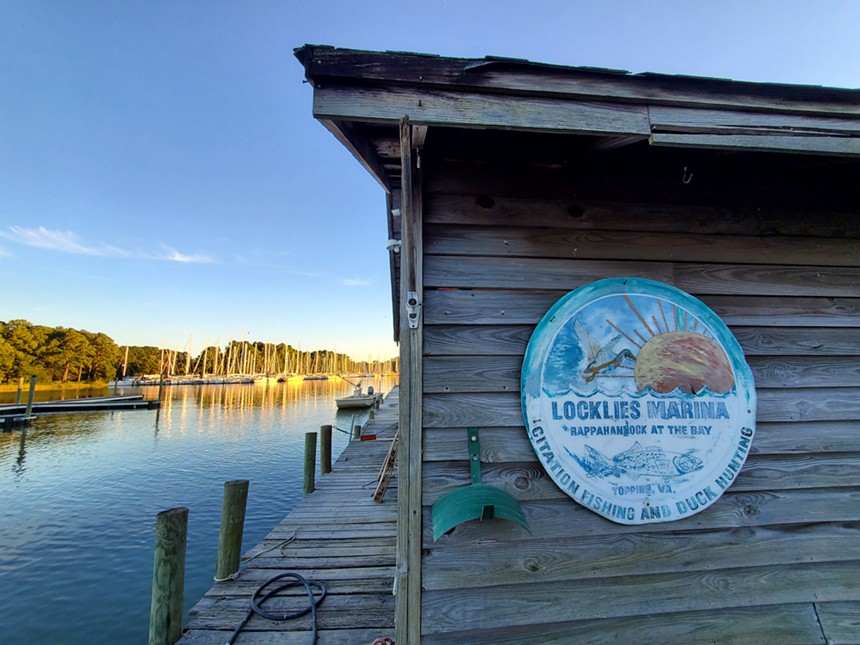
The view from the dock in Virginia where oysters make their first stop before heading on a place to Denver.
Molly Martin
The Croxtons have used that feedback to continue to learn and improve. "It's cool now to see how far they've come and how their nursery is growing, and how they've switched up the methods over the years as they're figuring out what yields the best oyster," Lucero says.
Even though Denver is far from the Rappahannock River, the experience of eating a Crassostrea virginica at Jax is identical to that of eating one within sight of the aquatic farm where they're grown — minus the waterfront view. "Some of the freshest seafood is going to be in places that have a really efficient airport," Ryan says, "and Denver's got one of the biggest and best airports in the country."
While eating local is lauded in Colorado, consuming products like Emersums have other benefits. "Oysters are one of the few food-production streams that have little to no impact other than a positive," Ryan notes. "Most of the food we grow in America is to feed animals. ... We don't grow any of [the food for the oysters]. This is all ambient food and, in fact, it's in excess in our waters because we have so few filter feeders to filter it out, so without [oysters], we have an imbalance."
The current number of oysters in the water is about 1 percent of what it was in 1900. "That's an imbalance, so we need to get more in there," Ryan concludes. "So in this case, eating oysters means putting oysters back into our waters and getting that filtering benefit from it, getting the excess nutrients out of it and balancing our waterways."

